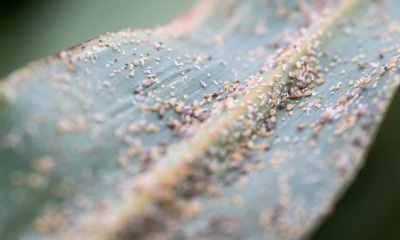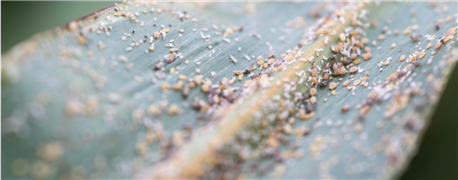
Chromatin Inc., a Lubbock, Texas company dedicated to sorghum breeding and research, is closing in on a better understanding of the resistance gene that protects plants from the sugar cane aphid, which is moving northward toward the major sorghum regions in Kansas and Nebraska.
Scott Staggenborg, Director of Product Portfolio & Technology Advancement at Chromatin, said researchers have been able to identify the source of resistance.
"We have identified the gene in our own parent material and we can introduce it without genetic modification," Staggenborg said in an interview during the Ag Media Summit in St. Louis.

GROWING PEST: Sugarcane aphids continue to be a growing problem for sorthum producers as the pest moves into Kansas and Nebraska.
He said an advantage to knowing the resistance source is that researchers don't have to keeping raising insects to use in testing plants to see which ones carry the gene.
So far, he said, only one source of resistance has been identified, though researchers are still working on finding more in laboratory trials.
He said that most of the resistant plants so far have been in medium to full season varieties and they are being tested in fields now in two Kansas locations, one near Mulvane and one near Ulysses.
The next big step after finding the gene will be determining the mode of action, or exactly how it protects the plant from aphid feeding.
"So far, what we have found with resistant plants is that the aphids chew less on them," he said. "The aphids are in the field, they just prefer other plants to those varieties. When we discover why, that will be the big breakthrough."
In the meantime, Staggenborg said, the best defense against the sugarcane aphid is the integrated prest management program developed by Chromatin's Sorghum Partners.
That strategy combines the use of multiple pest control tactics.
First, plant hybrids that are known for tolerance including SP6929, SP7715, K73-J6, SP70B17, SP78M30, SP68M57 or SP73B12. These hybrids are not resistant, but have been determined by USDA's Agricultural Research Service to have better tolerance to sugarcane aphids.
Second, implement cultural practices that combat pests. Those practices include management of residue levels after harvest, such as incorporation of stover; elimination of host plants such as Johnson grass that can sustain populations of aphids after sorghum is harvested; maintaining proper crop fertilization(higher than recommended levels of nitrogen) to help the plants withstand damage and cleaning machinery after harvest to limit the movement of the aphids.
Third, establish a sound sampling program and defined economic thresholds. Economic thresholds are dependent on levels of pest injury on the crop, commodity prices and the cost of applications. The management program urges producers to become familiar with the sugarcane aphid's biology and proper identification; monitor pest population density to determine when economic thresholds are reached. Those are 20 to 30% of plants infested or 100 sugarcane aphids per leaf.
Fourth, protect the natural enemies of the pest. Several known enemies can help keep populations below economic thresholds.
Fifth, if treatment becomes necessary, use approved chemical products. Seed treatments provide protection in the first 30 days after emergence. Once the economic threshold is reached, use legally permitted over-the-top chemical products, following label instructions.
About the Author(s)
You May Also Like






